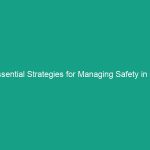Introduction
Good morning team! Today, we’re going to talk about an essential topic that directly impacts your Safety and well-being on the job: stretching. This Toolbox Talk will provide you with guidelines on stretching specifically designed for construction workers. Not only will these practices help prevent injuries, but they will also enhance your performance, allowing you to work more effectively and comfortably.
Understanding Essential Stretching 101
So, what exactly is “Essential Stretching 101”? It refers to a basic understanding of stretching techniques tailored for construction workers. Stretching is crucial in our line of work as it prepares your muscles for the demands of physical labor, reduces the risk of musculoskeletal injuries, and improves flexibility. Many of us might think stretching is optional or that we’re too busy to incorporate it into our routines, but neglecting it can lead to serious injuries that affect not only our work but also our daily lives.
Key Hazards, Risks, and Safety Considerations
Construction work often involves heavy lifting, repetitive motions, and awkward positions, all of which can lead to muscle strains and other injuries. Here are some common Hazards associated with not stretching:
- Muscle Strains: Without proper stretching, muscles can become tight and prone to injury.
- Reduced Flexibility: Not stretching can limit your range of motion, making it harder to perform tasks safely.
- Chronic Pain: Over time, neglecting stretching can lead to chronic pain in the back, shoulders, and legs.
Ignoring these safety protocols can have real-world consequences, including increased downtime due to injuries, higher medical costs, and even potential job loss. It’s essential to take stretching seriously to protect yourself and your fellow workers.
Best Practices, Procedures, & Actionable Advice
Now that we understand the importance of stretching, let’s discuss Best Practices and Procedures you can implement daily:
1. Warm-Up Before Stretching
Before diving into stretching, it’s important to warm up your muscles. Spend 5-10 minutes doing light aerobic activities like walking or jogging in place. This increases blood flow to your muscles, making them more pliable.
2. Focus on Major Muscle Groups
When stretching, pay attention to the major muscle groups used in construction work, including:
- Back
- Shoulders
- Legs
- Arms
3. Incorporate Dynamic Stretching
Dynamic stretching involves movement and is effective for preparing your body for physical activity. Here are some examples:
- Arm Circles: Stand with your arms extended and make small circles, gradually increasing the size.
- Leg Swings: Hold onto a stable surface and swing one leg forward and backward, then switch legs.
4. Use Static Stretching After Work
Static stretching is best done after your work shift. Hold each stretch for 15-30 seconds without bouncing to improve flexibility. Here are some effective static stretches:
- Hamstring Stretch: Sit with one leg extended and reach towards your toes.
- Shoulder Stretch: Bring one arm across your body and use the other arm to pull it closer.
5. Listen to Your Body
Always listen to your body. If you feel pain while stretching, stop immediately. Stretching should feel good and relieve tension, not cause discomfort.
Case Study: Real-World Example
Consider the case of a construction worker who developed chronic back pain due to neglecting stretching. After integrating a daily stretching routine, not only did their pain decrease, but their overall productivity and job satisfaction improved significantly. This illustrates how prioritizing stretching can lead to tangible Benefits on the job.
Regulations, Standards, and Compliance
While there may not be specific OSHA Regulations governing stretching, maintaining proper ergonomic practices is essential for compliance with general safety Standards. Companies often implement stretching programs as part of their safety protocols to reduce injuries and enhance worker well-being. Compliance with these standards protects you and promotes a safer work Environment.
Employee Engagement & Discussion
Now, let’s open the floor for discussion. I’d like to hear from you:
- What safety challenges have you encountered related to physical strain?
- Have you ever experienced an injury that could have been prevented by stretching?
- What stretching routines do you currently use, if any?
Your feedback is invaluable as we work together to create a safer workplace.
Conclusion & Key Takeaways
In conclusion, stretching is a vital practice that all construction workers should prioritize to enhance safety and performance. Remember the key points:
- Always warm up before stretching.
- Focus on major muscle groups that are heavily used.
- Incorporate dynamic stretches before work and static stretches afterward.
- Listen to your body and adjust your routine as needed.
Thank you for your attention today. Your commitment to safety is crucial not only for your well-being but also for your teammates. Let’s make stretching a part of our daily routine to ensure we all go home safe and healthy!


